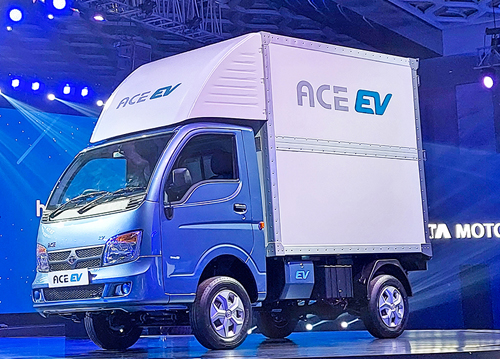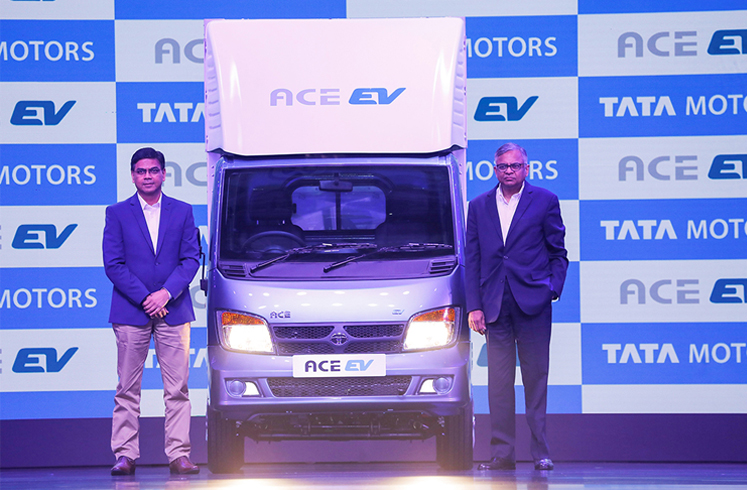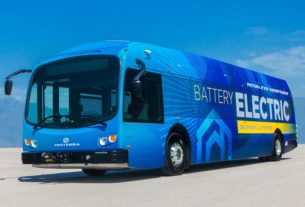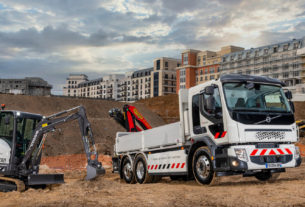With the new introduction, the company has entered a new era of e-cargo mobility

Girish Wagh and N. Chandrasekaran with senior executives from Amazon, BigBasket, City Link, DOT, Flipkart, LetsTransport,MoEVing and Yelo EV at the event
Tata Motors has marked a significant leap forward in its drive towards promoting sustainable mobility with the launch of the all-new, revolutionary Ace EV – the electric version of the ever-popular Ace, exactly 17 years after redefining India’s freight movement. The new Ace EV, India’s most advanced, zero-emission, four-wheel small commercial vehicle (SCV), is a green and smart transport solution ready to serve a wide variety of intra-city applications. Launching the Ace EV, N Chandrasekaran, Chairman, Tata Sons and Tata Motors, said, “E-mobility is an idea whose time has come. At Tata Motors, we are moving with speed and scale to lead this change in passenger cars, commercial vehicles and Jaguar Land Rover.”
“I am delighted today that with the launch of the Ace EV we are entering a new era of e-cargo mobility. Tata Ace is India’s most successful commercial vehicle ever. It has revolutionised transportation and created millions of successful entrepreneurs over the years. It will further build on this legacy by providing a technologically advanced, clean and smart mobility solution. I am excited about the electrification of commercial vehicles,” he added. The new Ace EV, co-developed in rich collaboration with its users and supported by a diligently curated ecosystem, offers a holistic solution for e-cargo mobility.

Girish Wagh and N. Chandrasekaran with senior executives from Amazon, BigBasket, City Link, DOT, Flipkart, LetsTransport, MoEVing and Yelo EV at the event
In addition to addressing the core need of timely cost-effective and efficient last-mile deliveries, the Ace EV also serves the future commitment and aspirations of its conscientious customers to achieve net zero carbon footprint. Tata Motors also announced signing of a strategic Memorandum of Understanding with leading e-commerce companies and logistics service providers such as Amazon, Big Basket, City Link, DOT, Flipkart, Lets Transport, MoEVing and Yelo EV. This includes delivering 39,000 units of the Ace EV, setting up dedicated electric vehicle support centres for maximum fleet uptime, deployment of Tata Fleet Edge – the next-gen optimal fleet management solution, and support of Tata UniEVerse, the proven enabling ecosystem of relevant Tata Group companies.
Speaking at the launch, Girish Wagh, Executive Director, Tata Motors, said, “The introduction of the Ace EV marks a major milestone in our journey to deliver zero emission cargo mobility in India. Building on our experience and success with electric buses, we have designed use case-specific EV solutions for intra-city distribution. These solutions effectively cater to the application needs and deliver a superior value proposition to all stakeholders. We are much encouraged with the support and response received from our e-commerce customers with whom we begin this journey of zero-emission cargo mobility.”
Transforming Logistics
The Ace EV is the first product featuring Tata Motors’ EVOGEN powertrain that offers an unparalleled certified range of 154 kilometres. It delivers a safe, all-weather operation with an advanced battery cooling system and regenerative braking system to boost the driving range. The vehicle allows regular and fast charging capabilities for high uptime. It is powered by a 27 kW (36 HP) motor with 130 Nm of peak torque to ensure highest cargo volume of 208 cubic feet and grade-ability of 22%, allowing easy ascend in fully loaded conditions. The Ace EV’s container is made of lightweight, durable materials that perfectly suit the requirements of e-commerce logistics. “A thorough mapping of customers’ duty cycle was carried out to accurately design and manufacture the Tata Ace EV,” Wagh said.
Ace EV is here to support our clients’ commitment towards net zero carbon footprint
The Ace EV is a complete electric vehicle with a full package of modern technology. This is what Rajendra M Petkar, President and Chief Technology Officer, Engineering Research Centre, Tata Motors, tells Rajesh Rajgor on the sidelines of the vehicle’s launch

With the unveiling of the all-new, ground-breaking Ace EV – the electric version of the ever-popular Ace – exactly 17 years after reinventing India’s last mile freight transportation, Tata Motors has taken a big step ahead in its drive to promote sustainable mobility. The new Ace EV, India’s most advanced zero emission four-wheel small commercial vehicle (SCV), is a green and smart intra-city transportation alternative. In this interview, Rajendra M Petkar, President and Chief Technology Officer, Engineering Research Centre, Tata Motors, elaborates about how the Ace EV, co-developed in rich collaboration with its users and supported by a diligently curated ecosystem, offers a holistic solution for e-cargo mobility. Excerpts from the interaction:
An EV is essentially a battery pack on wheels. Could you take us through the genesis of this product in terms of powertrain, the battery packs, thermal management and overall battery management system that makes the Ace EV vehicle so prominent?
First of all, this is not merely a vehicle packed with batteries; it is a complete electric vehicle with a full package of modern technology. The vehicle comes with several connected features like infotainment, tyre pressure monitoring system and is also extremely modern in terms of the cabin experience one gets. We started with addressing the need and therefore did not just create a vehicle for retail sales. We understood the application needs. What came from our market survey and interaction with possible customers like the e-commerce players was an understanding that the logistics service providers (LSPs) would be the frontrunners in adopting EVs in the SCV space. Tata Motors’ sustainable vision also matched up with many LSPs. Hence, today what you see in Tata Ace EV is a complete package to meet the needs of LSPs.
The Ace EV is the first vehicle to be equipped with Tata Motors’ EVOGEN powertrain, which has a certified range of 154 kilometres. With an innovative battery cooling system and regenerative braking technology to extend the driving range, it provides a safe, all-weather operation. The liquid cooled batteries are thermally protected and there is a radiator in the front. Adequate cooling passage in the battery pack ensures safety. There is also the cell monitoring that happens via the BMS and so all the basics are taken care of. For maximum uptime, the vehicle has regular and fast-charging capabilities. It is driven by a 27 kW (36 HP) motor with 130 Nm of peak torque to ensure the highest cargo volume of 208 cubic feet and grade-ability of 22%, allowing for simple ascent even when fully loaded. The Ace EV’s container is built of lightweight, long-lasting materials that are ideal for e-commerce logistics.
What were the first few steps that Tata Motors took to ensure the aggregates and the system put together meets the desired results?
When we interacted with the e-commerce players and understood the nature of the duty cycles and their applications based on their operations, we understood the start to end time of vehicles including the idling time across all the seasons. EVs have limitations when it comes to their recharge time as compared to an ICE vehicle that gets refuelled within minutes. Hence, a thorough mapping of customers’ operations was done to accurately design and manufacture the vehicle. It gave us confidence to advise customers about when their vehicle is idling and can recharge. Depending on the recess, customers can use fast-charging or at night time use slow-charging. The 15 amp socket (home charger) is aided for slow-charging for 7-8 hours. The fast-charging happens in 105 minutes. The 15 kw charger enables charging in both the options. As part of Tata UniEVerse, we have our group company Tata Power that is setting up charging infrastructure. Based on the e-commerce companies’ operations, charging networks are being set up across the country.

Could you share insights about the features added to the ACE EV post your study with e-commerce players with respect to applications, torque and GVW?
First of all, our study for intended applications helped us define the product attribute features very well. In terms of the duty cycle, we got to know the number of start and stops, the kind of acceleration, the topography, gradient, traffic situation, and range in terms of vehicle operation and charging time (idling time) that a vehicle will experience. A lot has been invested in terms of the collaboration between us and the logistics service providers. It has been co-developed with users and supported by a carefully curated ecosystem that provides a comprehensive solution for e-cargo mobility. In addition to meeting the essential demand for fast, cost-effective and efficient last-mile deliveries, the Ace EV supports its conscientious clients’ future commitment and goals to attain net zero carbon footprint.
What gives you the confidence that Tata Ace EV will fare better than the traditional Ace internal combustion engine (ICE) vehicle in the long run?
The operating cost of an EV is low compared to the ICE. In ICE, we convert the diesel into chemical energy which is then transformed into heat and then into mechanical energy which reaches the tyres. In the case of battery EV, you convert the stored energy into mechanical energy. Hence, the EV powertrain is very efficient and higher than ICE. In terms of rupees per kilometre, it is much lower than the ICE engine. Once the initial acquisition cost is surpassed, the total cost of ownership is much better than ICE. Additionally, we work on standard range and batteries that meet the required applications. We will cater to the need once we aggregate the demand and know a pattern. We are sure that there is significant underlining demand for cargo EVs across several applications but at the moment we are catering to closed loop applications and are working with specific customers to gradually move to other applications.
Could you elaborate about the peripherals that aid in better EV experience for fleet operators?
We call these features as connected vehicle specific to EV operation. The driver is able to locate the nearest charging station, find out how much charge is left in the battery and the battery temperature too is showcased. There are also features like geo-fencing and track and trace of the vehicle. The fleet management team can also coordinate with a driver and forewarn him in case of any problem. The topography, shortest route and facility details are provided as part of the connected features. We also have voice recognition as in some of the passenger vehicles such as ‘Hello Tata’ or ‘Hey Tata’ that can respond to basic questions like ambient temperature of the vehicle, the charge balance, etc.
What is the manufacturing setup for Ace EV at the moment?
The Ace EV will be manufactured at the Pantnagar plant where the conventional Ace ICE is being manufactured. Parts are sourced from a number of locations and what is important is the local designing, local value-addition, local engineering, local manufacturing and the end-of-line testing. It goes without saying that all this is to support the government’s EV agenda through leveraging FAME incentives and participation in the PLI scheme. These are all part of a bigger strategy.
What would you want to share regarding driver comfort as the drivers of ICE vehicle usually fear losing the pick-up and torque in an electric vehicle?
From the user point, the Ace EV is extremely comfortable. Drivers do not have to change the gear – just R N and D for movement of the vehicle. The powertrain is low on noise, vibration and harshness (NVH). The drivers would be delighted with the torque and the pick-up is not at all compromised as our motor is not undersized. We have a strong powertrain here with 27 kw motor with 130 Nm of torque.





